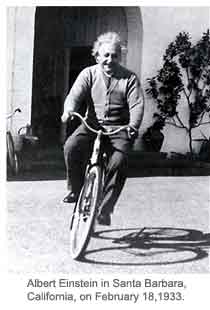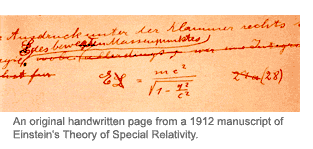Teaching with Einstein
Exploring the Mind of a Genius
The current Einstein exhibit at the American Museum of Natural History in New York City, which runs until August 10, 2003, offers a unique and superb opportunity for teachers of many subjects at the high school and college level. It is a chance to examine and experience the work, mind, and life of one of the few universally recognized geniuses. Students of science, mathematics, history, political science, and psychology, even without visiting the museum, can use the exhibit's resources to enhance their understanding of their respective subjects and appreciate Albert Einstein's important contributions. The exhibit's resources include a Web site, an Educator's Guide to the Exhibition, and reference lists of Web sites and books, all of which are available at the Museum's Web site for the exhibit (available in "See also" below).

As the Einstein exhibit demonstrates, one of the most important reasons for his greatness was his originality. Einstein's pioneering work in quantum mechanics and relativity built on amazing leaps of his imagination. He used thought experiments to visualize situations that even today are still difficult to grasp. Like other great thinkers, he challenged and transformed accepted ideas.
In this way, Einstein demonstrated the truth of one of his favorite sayings, "Imagination is more important than knowledge." This attitude of Einstein and other creative people can help motivate teachers to instill a spirit and appreciation for originality in both their teaching and their students. Inspiring students to think for themselves will help them on the way to become life-long learners.
Knowledge Is Not Enough
Einstein's stress on imagination adds to a current educational debate. In essence he said that cultural, quantitative, and scientific literacy—knowledge—is a good thing, but it is not enough. Such knowledge is the jumping-off point, the springboard for the creative leap. It is the "shoulders of giants" on which Newton and then Einstein had to stand in order to make their own new contribution.
In Einstein's case, his originality contradicted much conventional wisdom. He showed that the Newtonian view of the universe did not work at the very small scale and the very large scale. Even today, his notions of relativity and curved space-time are mind-bending because they seem at odds with our common intuition and observation. But despite ordinary experience, Einstein knew that his theories were right, and his faith was proven correct by observations during a solar eclipse in 1919, which made Einstein a world figure.
Contradiction was a part of Einstein's life. Not only did he contradict previously existing scientific thought, but aspects of his life and opinions also seem to be inconsistent. Although he is credited as the godfather of the atomic bomb, he was a staunch pacifist. Although he was a patriotic, naturalized American citizen, he was considered a security risk by the government. Although he was a gentle, kind, and caring person, his own family relationships were very difficult. While Einstein looked for grand theories to explain all physical phenomena—the Unified Theory—he would have had a hard time trying to reconcile all the aspects of his own personal life.

Once he achieved international fame, Einstein was able to use his superstar status to champion nonscientific causes. In the early 1950s, he opposed McCarthyism at great personal risk. Throughout his life, he was a socialist. He favored world government as a means to avoid future wars of unfathomable destruction. Einstein was a strong advocate for the state of Israel and also used his celebrity to speak out against racial and ethnic discrimination. By virtue of his unique position, when Einstein talked on any subject, people listened.
Einstein's Far-Reaching Influence
One of the most surprising lessons from the Einstein exhibit is how many different subject areas teachers can teach from Einstein. Some of Einstein's early work led directly to X-ray crystallography, which in turn led to the discovery of DNA and today's genomics. Science students will recognize Einstein's use of dimensional analysis in his work. Einstein valued mathematics, always working hard to get it correct, and calculus students will certainly appreciate seeing the derivatives and integrals sprinkled throughout his manuscripts (available on the exhibit's Web site, as well as at the exhibit). And any student can surely wonder at the deceptive simplicity of his famous equation about the relationship between energy and mass, E = mc2.
Einstein's life intersected with many of the great events and persons of the twentieth century. He is responsible for many of the developments and current lines of thought in the physical sciences in the past 100 years, including astronomy, astrophysics, and cosmology. But quite apart from science, Einstein played a role in political and social change. He corresponded with leaders in other fields, including President Roosevelt, Sigmund Freud, and Bertrand Russell. It is fascinating to actually see the original letters exchanged between these notable people on display in the exhibit (and on the exhibit's Web site).
All aspects of Einstein's life and work are included in the exhibit. We get to see his human side through letters to lovers and his children, his intellectual achievements, and the vast reach of his work on social and humanitarian causes. A rich source of stimulation and information, the exhibit is bound to encourage and invite further study and discussion by students and teachers alike of Einstein, his life, his work, and his ideas. His achievements include so much that they provide an endless source of interest. Even today, almost 50 years after his death, we still are amazed at what Einstein, this quiet and unassuming man, accomplished.
The American Museum of Natural History (AMNH) is offering several events, talks, workshops, and performances (Einstein's Dreams, Einstein and Love, and Cosmic Cabaret) in connection with the Einstein exhibit. A schedule is available on the exhibit's Public Programs Web site. The Museum also offers online seminars for graduate credit (the Einstein seminar begins February 3, 2003); professional development days at the Museum are offered through the New York City Department of Education.
Photo Credits
AP Central home page: Albert Einstein on the observation deck of the Empire State Building, probably in the early 1930s. Courtesy of the Manuscripts Division, Department of Rare Books and Special Collections, Princeton University Library.
Einstein on bicycle: Courtesy of the Archives, California Institute of Technology.
Special Relativity manuscript: From the Israel Museum, Jerusalem.
Authored by
Susan Kornstein
Director, Content Development, The College Board